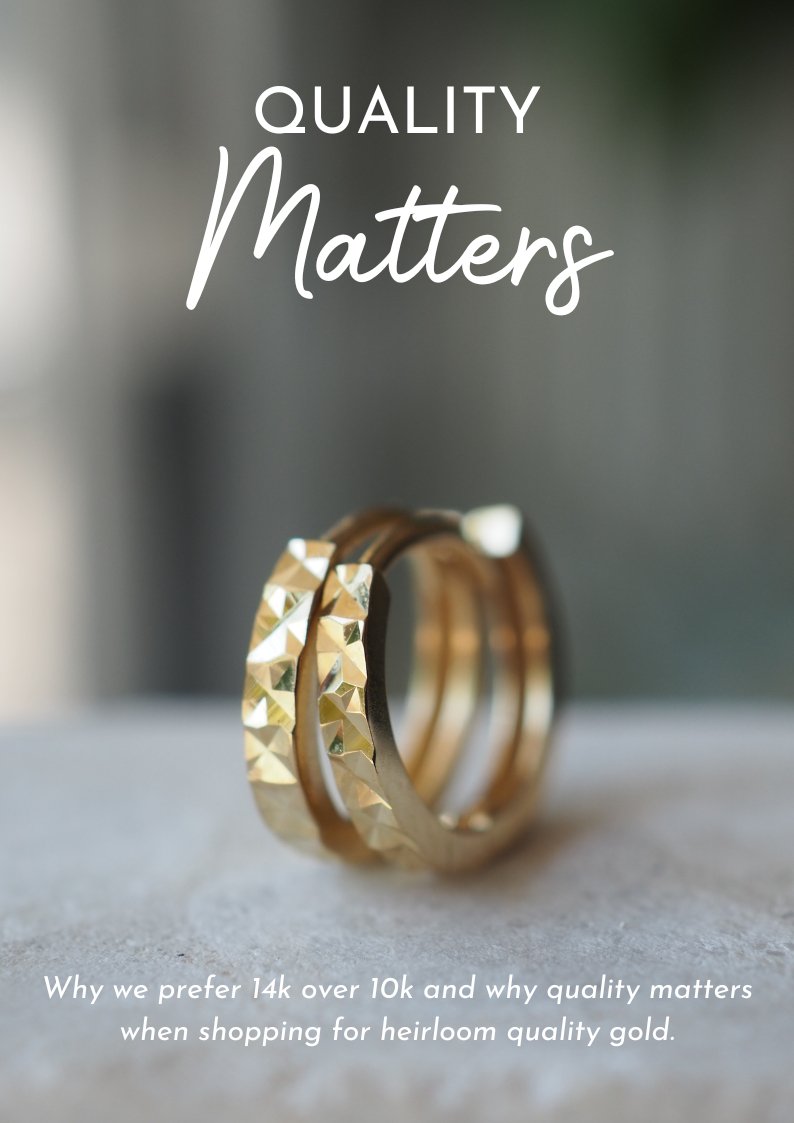Karats: Why we prefer 14k over 10k at LanaBetty

At LanaBetty, we are obsessed with every aspect of our jewelry. Investing in quality materials like 14k gold is an investment in yourself and the longevity of the jewelry you choose. 14k gold will never tarnish. It looks excellent on all skin tones. And perhaps most importantly, its value increases over time, as opposed to the fast-fashion, gold-plated trash you see at discount clothing stores.
KARAT VS. CARAT: HOW GOLD PURITY IS MEASURED
The purity of gold is categorized using the karat system. The karat system measures the ratio of pure gold to other alloys in a piece of gold jewelry. The greater the amount of pure gold in a gold ring or other piece of jewelry, the higher the purity level.
This is different than the Carat system, is used to describe the size of precious stones and pearls, equivalent to 200 milligrams. An example is a 4mm diamond is roughly 0.5c in size.
ISN’T ALL GOLD JEWELRY MADE USING PURE GOLD?
Believe it or not, most jewelry you buy, gold jewelry that is, probably isn't 100% gold. 999 gold, pure gold, or 24k gold, is gold that hasn’t been mixed with any other metals. While 24k gold sounds luxurious, we aren't really big fans of 24k and 24k gold isn’t used for jewelry for several reasons:
- Hardness: 24k gold is extremely soft. Because pure gold is so soft, it bends and warps easily, making it a poor metal for jewelry that needs to retain its shape (think: rings). Pure gold also scratches easily, meaning it doesn’t take long for pure gold jewelry to become scuffed and unattractive.
- Color: 24k gold is bright. The color of pure gold is much brighter and more orange than what most people associate with the gold used in jewelry. Because of this, it generally isn’t an attractive metal for rings, watches and other gold jewelry.
- Price: 24k gold is extremely expensive. Pure gold contains almost twice as much gold as 14k gold (the most popular type of gold used for jewelry in the US), meaning it costs much more to produce jewelry using this metal. As an example, that would mean 24k gold sleeper earrings would be priced over $250 compared to $148 for 14k gold sleeper earrings (here).
Because of these factors, it’s very uncommon for 24k gold to be used in jewelry.
Shop our 14k Gold Collection now.
10K, 14K, 18K AND 24K GOLD: WHAT’S THE DIFFERENCE?
Gold purity content is categorized using the karat system. Depending on the ratio of pure gold to other alloys, the gold used in engagement rings and other jewelry is usually categorized as 10k, 14k, 18k, 22k and 24k.

Each type of gold has a different purity level. Pure gold, or 24k gold, is 100% pure. 10k gold, on the other hand, is only 41.7% pure. 14k gold, which is the most popular type of gold for jewelry, is 58.3% pure.

There’s no “best” type of gold for every application. Instead, each purity level has its own range of advantages and disadvantages. Let's talk about why we love 14k instead of 10k.
14K GOLD: THE GOLD THAT'S JUST RIGHT
- Pro: A great mix of purity, durability and value.
- Con: More expensive than 10k gold.
14 karat gold is made up of 58.3% gold and 41.7% alloy, or 14 out of 24 parts gold. 14k gold is the most popular gold for rings and other wearable jewelry in the United States, the UK and the other Western countries.
Most of all engagement and wedding rings are made from 14k gold, making this a good go-to choice if you are not sure which type of gold is best. We like it the most, because it is sturdy, a beautiful color, and because it is more than 50% gold, is inert for most skin sensitivities.
WHICH TYPE OF GOLD IS BEST FOR YOU?
There’s no "best" type of gold for everyone. When choosing the type of gold for an investment jewelry, it is important to keep factors such as you or your partner’s skin sensitivity, career, activity level and aesthetic taste in mind.
Can we also talk about budget? While an 18k ring might look fantastic, it is definitely going to cost significantly more than a similar option in 14k or 10k gold.
Most of the time, 10 karat gold isn’t used for engagement rings. Because the difference in price between 14k and 10k gold is so negligible, the vast majority of reputable jewelers will offer 14k as their most affordable option for engagement rings.
Need help choosing the right engagement ring? Let's talk. We can schedule a call or studio visit and can offer personalized advice on quality options for your budget.
14k gold has a rich color, with the classic gold appearance that most customers look for in rings and other jewelry. Its color is slightly less saturated and intense than 18 karat gold, making it an excellent choice if you want gold jewelry that’s rich and attractive but not overly yellow.
Compared to 18k gold, the main advantages of 14k gold are its durability and affordability. Rings and other jewelry made using 14k gold are significantly more durable than those made with 18k gold, making this type of gold a good choice if you’re concerned about scuffs and scratches.
 LanaBetty 15mm Sleepers, 14k gold
LanaBetty 15mm Sleepers, 14k gold
14k gold is also more affordable than 18k, making it a good all-round option if you’re looking for a mix of quality, durability and value for money.
10K GOLD: THANK YOU, NEXT
- Pro: Very affordable, more durable than other types of gold.
- Con: Pale yellow color, more likely to trigger metal allergies.
10 karat gold is made up of 41.7% gold and 58.3% alloy, or 10 out of 24 parts gold. 10k gold is the least pure, least expensive and most durable form of gold used in jewelry. It’s also the most impure gold can be while remaining legally “gold” in North America.
Aesthetically, 10k gold has a pale appearance, with a significantly less rich yellow tone than 14k or 18k gold. Its pale color is something you either like or don’t — some people like it for its visual subtlety, while others prefer the rich gold tone of 14k and 18k gold jewelry.
The biggest advantages of 10k gold are its cost and durability. 10k gold is the most budget friendly, making it a good option if you’re shopping for a ring or other jewelry on a tight budget.
The main disadvantage of 10k gold is its risk of causing skin irritation if you’re allergic to certain metals. If you’re allergic to copper, silver, nickel, zinc, or iron, it’s possible for your skin to break out with allergic contact dermatitis if you wear a 10k gold ring for a long period of time. That right there, folks, is why we are committed to providing quality gold for your fingers, ears, and necks.
So we want to know, what karat of gold do you prefer?













